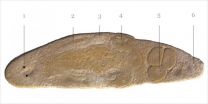(Press-News.org) BARCELONA-LUGANO, 1 July 2015 - The SENRI trial has opened the window to evaluate NK1 antagonists for emesis prevention in patients taking oxaliplatin chemotherapy, antiemetics expert and ESMO spokesperson Fausto Roila said, putting into perspective the results of a Japanese study presented today at the ESMO 17th World Congress on Gastrointestinal Cancer 2015 in Barcelona.
Roila's comments came as the SENRI Trial results were presented including a new gender analysis (1),(2). He said: "Until now we said that NK1 antagonists have no role in the prevention of emesis in oxaliplatin chemotherapy, classified as having a moderate emetogenic risk only."
The multicentre, open label, randomised phase III SENRI Trial evaluated the NK1 antagonist aprepitant for the prevention of nausea and vomiting induced by oxaliplatin-based chemotherapy in Japanese patients with colorectal cancer. Patients were randomised in a 1:1 ratio to the control group (5-HT3 receptor antagonist + dexamethasone) or aprepitant group (5-HT3 receptor antagonist + dexamethasone + aprepitant or fosaprepitant (3)) in the first course. All patients were treated with aprepitant/fosaprepitant in the second course. The primary endpoint was the rate of patients with no emesis. The results presented today also include a new analysis of the potential effect of gender on treatment response.
The trial enrolled 413 patients from 25 centres in Japan. Significantly more patients in the aprepitant group achieved no vomiting overall and in the delayed phase than those in the control group. Rates of overall complete response were lower in women compared to men in both the control and aprepitant groups. In women the rates of no nausea and complete protection were significantly higher in the aprepitant group compared to the control group.
"We found that the three-drug combination antiemetic therapy of aprepitant, a 5-HT3 receptor antagonist and dexamethasone significantly increased the inhibition rate of vomiting and nausea," said lead study author Junichi Nishimura, assistant professor at Osaka University in Japan. "The inhibition rate was especially clear in females. This three-drug combination might be a good antiemetic treatment option for oxaliplatin-based chemotherapy in patients with colorectal cancer."
Standard prophylaxis for the prevention of acute emesis is a 5-HT3 receptor antagonist plus dexamethasone, and for delayed emesis is corticosteroids. The only previous randomised trial evaluating the addition of an NK1 antagonist to prevent oxaliplatin induced emesis found no benefit.(4)
"Unfortunately the two studies gave different results," said Roila, who is one of the chairs of the Multinational Association of Supportive Care in Cancer (MASCC) and ESMO Antiemetic Guidelines Committee and director of the Medical Oncology Division, Santa Maria Hospital in Terni, Italy. "My opinion is that because we have contrasting results we need to await new data from other studies before we can conclude whether or not NK1 antagonists can be added to a 5-HT3 receptor antagonist plus dexamethasone in patients treated with oxaliplatin-based chemotherapy."
A study evaluating fosaprepitant for the prevention of emesis in moderately emetogenic chemotherapy including oxaliplatin found that it increased complete protection above ondansetron plus dexamethasone alone.(5) Roila said: "We need a subgroup analysis in patients receiving oxaliplatin-based chemotherapy to evaluate the efficacy of fosaprepitant versus placebo when both are combined with a 5-HT3 antagonist and dexamethasone."
Commenting on the new gender analysis from the SENRI Trial presented today, Roila said: "Women generally experience more chemotherapy induced emesis than men. The addition of aprepitant induced an increase of overall complete response both in males and in females, from 64% to 78% in females and from 81% to 90% in males."
He concluded: "The findings of the SENRI Trial have important implications because they raise the possibility that NK1 antagonists may prevent emesis in patients treated with oxaliplatin-based chemotherapy. Oxaliplatin is a widely used antineoplastic drug both as adjuvant treatment for colorectal cancer and for the metastatic diseases of many cancers of the gastrointestinal tract, the pancreas and the biliary tract."
INFORMATION:
References
1 Abstract O-0001 'A phase III trial of aprepitant in colorectal cancer patients receiving oxaliplatin-based chemotherapy (SENRI Trial)' will be presented by Junichi Nishimura during Session I: Opening, Selected Abstracts, and Keynote Lecture on Wednesday 1 July, 14:15.
2 Nishimura J, Satoh T, Fukunaga M, Takemoto H, Nakata K, Ide Y, Fukuzaki T, Kudo T, Miyake Y, Yasui M, Morita S, Sakai D, Uemura M, Hata T,Takemasa I, Mizushima T, Ohno Y, Yamamoto H, Sekimoto M, Nezu R, Doki Y, Mori M; Multi-center Clinical Study Group of Osaka, Colorectal Cancer Treatment Group (MCSGO). Combination antiemetic therapy with aprepitant/fosaprepitant in patients with colorectal cancer receiving oxaliplatin-based chemotherapy (SENRI trial): A multicentre, randomised, controlled phase 3 trial. Eur J Cancer. 2015 Jul;51(10):1274-1282. doi: 10.1016/j.ejca.2015.03.024. Epub 2015 Apr 24.
3 Fosaprepitant is a prodrug of aprepitant.
4 Hesketh PJ, Wright O, Rosati G, Russo M, Levin J, Lane S, Moiseyenko V, Dube P, Kopp M, Makhson A. Single-dose intravenous casopitant in combination with ondansetron and dexamethasone for the prevention of oxaliplatin-induced nausea and vomiting: a multicenter, randomized, double-blind, active-controlled, two arm, parallel group study. Support Care Cancer. 2012 Jul;20(7):1471-1478. doi: 10.1007/s00520-011-1235-4. Epub 2011 Aug 7.
5 Rapoport BL, Weinstein C, Camacho ES, Khanani SA, Beckford-Brathwaite E, Kevill L, Vallejos W, Liang LW, Noga SJ. A phase III, randomized, double-blind study of single-dose intravenous fosaprepitant in preventing chemotherapy-induced nausea and vomiting associated with moderately emetogenic chemotherapy. J Clin Oncol. 2015;33 (suppl; abstr 9629).
BARCELONA-LUGANO, 1 July 2015 - Patients with the lowest body mass index (BMI) had the shortest overall survival in an analysis of bevacizumab studies in metastatic colorectal cancer (mCRC) presented for the first time today at the ESMO 17th World Congress on Gastrointestinal Cancer 2015 in Barcelona.(1)
"There is good evidence that obesity increases the risk of getting colorectal cancer and that it increases the risk of colorectal cancer recurrence after curative therapy," said lead study author Dr Yousuf Zafar, associate professor of medicine at Duke Cancer Institute ...
DURHAM, N.C. - Although being overweight with a high body-mass index (BMI) has long been associated with a higher risk for colorectal cancer, thinner patients might not fare as well after treatment for advanced cancer, according to a new study from Duke Medicine.
The study, which was presented today at the European Society for Medical Oncology World Congress on Gastrointestinal Cancer, found that patients with a low to healthy body weight lived an average of two-and-a-half months less than overweight and obese patients.
The results surprised researchers, who expected ...
Lexington, Mass., July 1, 2015 - Substituting deuterium for certain hydrogen atoms in molecules has been shown to enhance the metabolic properties of a number of drugs and provides a promising approach to the discovery and development of innovative drug products. The deuterium chemistry approach has the potential to reduce the high failure rates of conventional drug development by building on the known pharmacology of existing compounds and leveraging their desirable therapeutic properties. Selective deuterium substitution as a means of ameliorating unwanted clinically ...
Working in cell cultures and mice, researchers at Johns Hopkins have found that an experimental drug called fostamatinib combined with the chemotherapy drug paclitaxel may overcome ovarian cancer cells' resistance to paclitaxel.
Scientists elsewhere are already testing fostamatinib in people with lymphoma and idiopathic thrombocytopenia purpura, an autoimmune disorder. Based on results of the current study described in a report online June 18 in the journal Cancer Cell, Johns Hopkins researchers say they are planning a phase I clinical trial to test the paclitaxel-fostamatinib ...
A team from the RIKEN Center for Emergent Matter Science, along with collaborators from several Japanese institutions, have successfully produced pairs of spin-entangled electrons and demonstrated, for the first time, that these electrons remain entangled even when they are separated from one another on a chip. This research could contribute to the creation of futuristic quantum networks operating using quantum teleportation, which could allow information contained in quantum bits--qubits--to be shared between many elements on chip, a key requirement to scale up the power ...
St John's Wort can produce the same adverse reactions as antidepressants, and serious side effects can occur when the two are taken together, according to new University of Adelaide research.
In a study published this month in the journal, Clinical and Experimental Pharmacology and Physiology, researchers compared the pattern of spontaneous reported adverse drug reactions to St John's Wort, a herbal treatment for depression, and fluoxetine, a commonly prescribed antidepressant. They found the adverse reactions were the same for people who took St John's Wort as it was ...
A research in the North Caucasus, conducted by a group of Russian scientists over three years, has revealed an intermediate distribution of Caucasian populations of non-biting midges between Europe and Siberia. Their observations also proved some interesting morphological distinctions between the studied populations and the previously researched ones from Europe and Siberia. Their results have been published in the open-access journal Comparative Cytogenetics.
The study on karyotypical and morphological peculiarities of Ch. bernensis is a part of the investigation of ...
Sandcastles are a prime example of how adding a small amount of liquid to a granular material changes its characteristics. But understanding the effect of a liquid wetting randomly oriented fibres in a fibrous medium remains a mystery. Relevant to the building industry, which uses glass wool, for instance, this phenomenon can be better understood by studying the behaviour of a liquid trapped between two parallel fibres. It can either remain in the shape of a drop or spread between the fibres into a long and thin column of liquid. Now, scientists have demonstrated that the ...
Failing to find a mating partner is a dent to the reproductive prospects of any animal, but in the flatworm species Macrostomum hystrix it might involve a real headache. Zoologists from the Universities of Basel and Bielefeld have discovered the extraordinary lengths to which this animal is willing to go in order to reproduce - including apparently injecting sperm directly into their own heads. The academic journal Proceedings of the Royal Society B has published their findings.
The absence of a mate usually spells disaster for sexually reproducing animals. However, some ...
Atoms absorb and emit light of various wavelengths. Physicists have long known that there are some tiny changes, or shifts, in the light that gets absorbed or emitted, due to the properties of the atomic nucleus. Now, a team of scientists has elucidated the so-called hyperfine structure of cadmium atoms. Relying on a method called laser spectroscopy, they have measured variations in the energy transition within cadmium atom - Cd in the periodic table. They studied a chain of isotopes with an odd number of neutrons ranging from 59 in 107Cd to 75 in 123Cd. From these high-precision ...


